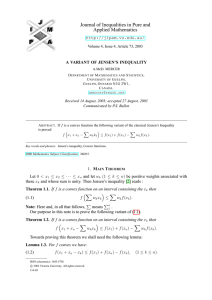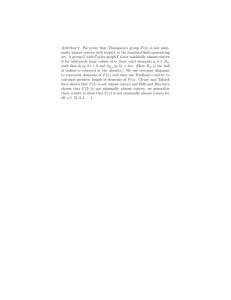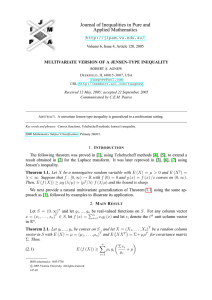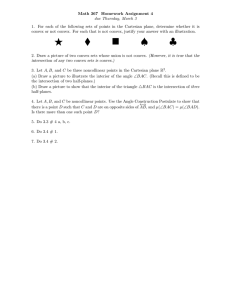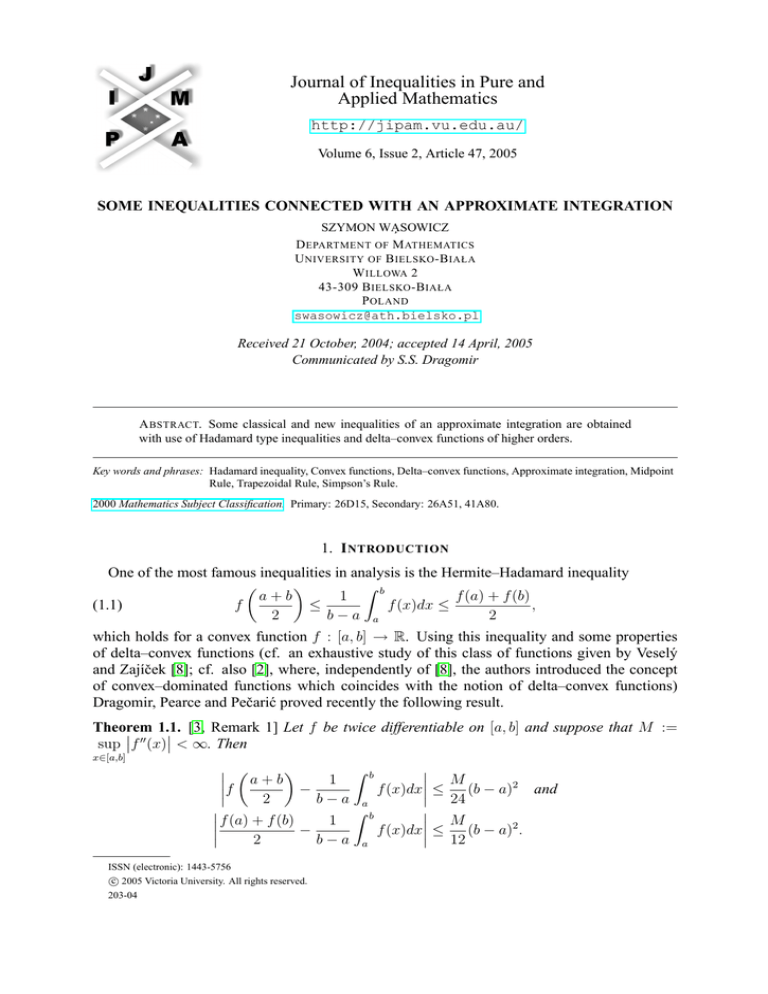
Journal of Inequalities in Pure and
Applied Mathematics
http://jipam.vu.edu.au/
Volume 6, Issue 2, Article 47, 2005
SOME INEQUALITIES CONNECTED WITH AN APPROXIMATE INTEGRATION
SZYMON WA̧SOWICZ
D EPARTMENT OF M ATHEMATICS
U NIVERSITY OF B IELSKO -B IAŁA
W ILLOWA 2
43-309 B IELSKO -B IAŁA
P OLAND
swasowicz@ath.bielsko.pl
Received 21 October, 2004; accepted 14 April, 2005
Communicated by S.S. Dragomir
A BSTRACT. Some classical and new inequalities of an approximate integration are obtained
with use of Hadamard type inequalities and delta–convex functions of higher orders.
Key words and phrases: Hadamard inequality, Convex functions, Delta–convex functions, Approximate integration, Midpoint
Rule, Trapezoidal Rule, Simpson’s Rule.
2000 Mathematics Subject Classification. Primary: 26D15, Secondary: 26A51, 41A80.
1. I NTRODUCTION
One of the most famous inequalities in analysis is the Hermite–Hadamard inequality
Z b
a+b
1
f (a) + f (b)
(1.1)
f
≤
f (x)dx ≤
,
2
b−a a
2
which holds for a convex function f : [a, b] → R. Using this inequality and some properties
of delta–convex functions (cf. an exhaustive study of this class of functions given by Veselý
and Zajíček [8]; cf. also [2], where, independently of [8], the authors introduced the concept
of convex–dominated functions which coincides with the notion of delta–convex functions)
Dragomir, Pearce and Pečarić proved recently the following result.
Theorem
00 1.1.
[3, Remark 1] Let f be twice differentiable on [a, b] and suppose that M :=
sup f (x) < ∞. Then
x∈[a,b]
Z b
a
+
b
1
f
≤
−
f
(x)dx
2
b−a a
Z b
f (a) + f (b)
1
−
f (x)dx ≤
2
b−a a
ISSN (electronic): 1443-5756
c 2005 Victoria University. All rights reserved.
203-04
M
(b − a)2
24
M
(b − a)2 .
12
and
2
S ZYMON W A̧SOWICZ
By multiplying both sides of these inequalities by b − a the simplest cases of the inequalities
estimating the accuracy of the Midpoint and Trapezoidal Rules of an approximate integration
can be recognized.
In this paper we give some results related to Theorem 1.1. Some new inequalities are obtained
and some known inequalities are reproved. To obtain these results we make use of an important
extension of convex functions, i.e. convex functions of higher orders (studied among others by
Popoviciu [6]). Let us recall this notion. It is not difficult to notice that a function f : I → R
(where I ⊂ R is an interval) is convex if and only if
1
1
1 x
y
z ≥ 0
(1.2)
f (x) f (y) f (z)
for any x, y, z ∈ I such that x < y < z. Following this observation we define the function
f : I → R to be n–convex (n ∈ N) if and only if
1
1
...
1 x0
x1
...
xn+1 .
..
..
...
≥0
Dn+1 (x0 , x1 , . . . , xn+1 ; f ) := ..
.
.
xn
...
xnn+1 xn1
0
f (x ) f (x ) . . . f (x )
0
1
n+1
for any x0 , x1 , . . . , xn+1 ∈ I such that x0 < x1 < · · · < xn+1 . Obviously 1–convex functions
are convex in the classical sense. For more information about the definition and the properties
of convex functions of higher orders the reader is referred to [5], [6], [7].
The following theorem (due to Popoviciu [6]) characterizes n–convexity of n + 1 times differentiable functions (cf. also [5], [1, Theorem A]).
Theorem 1.2. Assume that f : (a, b) → R is an n + 1 times differentiable function. Then f is
n–convex if and only if f (n+1) (x) ≥ 0, x ∈ (a, b).
The result similar to the if part of Theorem 1.2 is true for f : [a, b] → R. The expression
“f : [a, b] → R is continuous” means, as usual, that f is continuous on (a, b), continuous on the
right at a and continuous on the left at b.
Theorem 1.3. Assume that f : [a, b] → R is n + 1 times differentiable on (a, b) and continuous
on [a, b]. If f (n+1) (x) ≥ 0, x ∈ (a, b), then f is n–convex.
Proof. The result follows by Theorem 1.2 and by the fact that the functions Dn+1 (·, x1 , . . . ,
xn+1 ; f ) and Dn+1 (x0 , . . . , xn , ·; f ) are continuous on the right at a and on the left at b, respectively.
In [1] Bessenyei and Páles recently obtained some extensions of Hadamard’s inequality (1.1)
for convex functions of higher orders ([1, Theorems 6 and 7]). Since the notations of these
results will be used very often in the present paper, we quote these theorems in extenso. Let us
remark that in [1] the name n–monotone functions is used for (n − 1)–convex functions. For
reader’s convenience we consequently use this last name.
Theorem 1.4. [1, Theorem 6] Let, for n ≥ 0,
1
1
···
2
1
x
···
3
pn (x) := .
..
..
..
.
.
n 1
x n+2 · · ·
J. Inequal. Pure and Appl. Math., 6(2) Art. 47, 2005
.. ,
. 1 2n+1
1
n+1
1
n+2
http://jipam.vu.edu.au/
S OME I NEQUALITIES C ONNECTED WITH AN A PPROXIMATE I NTEGRATION
3
then pn has n pairwise distinct roots in (0, 1). Denote these roots by λ1 , . . . , λn and
Z 1
1
α0 := 2
p2 (x)dx,
pn (0) 0 n
Z 1
1
xpn (x)
αk :=
dx
λk 0 (x − λk )p0n (λk )
(k = 1, . . . , n).
Then the following inequalities hold for any 2n–convex function f : [a, b] → R:
(1.3)
(1.4)
n
X
Z b
1
f (x)dx and
α0 f (a) +
αk f (1 − λk )a + λk b ≤
b
−
a
a
k=1
Z b
n
X
1
f (x)dx ≤
αk f λk a + (1 − λk )b + α0 f (b).
b−a a
k=1
Theorem 1.5. [1, Theorem 7] Let, for n ≥ 1,
1
x
pn (x) := .
..
n
x
1
···
1
2
..
.
···
..
.
1
n+1
···
1 n 1 n+1 .. ,
. 1 2n
1
x
qn (x) := .
..
n−1
x
1
2·3
1
3·4
···
..
.
···
..
.
1
(n+1)(n+2)
···
1
n(n+1) 1
(n+1)(n+2) ..
.
1
(2n−1)2n
,
then pn has n, and qn has n−1 pairwise distinct roots in (0, 1). Denote these roots by λ1 , . . . , λn
and µ1 , . . . , µn−1 , respectively. Let
Z
1
pn (x)
dx (k = 1, . . . , n) and
0
0 (x − λk )pn (λk )
Z 1
1
β0 := 2
(1 − x)qn2 (x)dx,
qn (0) 0
Z 1
1
x(1 − x)qn (x)
βk :=
dx (k = 1, . . . , n − 1),
(1 − µk )µk 0 (x − µk )qn0 (µk )
Z 1
1
βn := 2
xqn2 (x)dx.
qn (1) 0
αk :=
Then the following inequalities hold for any (2n − 1)–convex function f : [a, b] → R:
n
X
(1.5)
(1.6)
1
b−a
Z b
1
αk f (1 − λk )a + λk b ≤
f (x)dx and
b−a a
k=1
Z b
n−1
X
f (x)dx ≤ β0 f (a) +
βk f (1 − µk )a + µk b + βn f (b).
a
J. Inequal. Pure and Appl. Math., 6(2) Art. 47, 2005
k=1
http://jipam.vu.edu.au/
4
S ZYMON W A̧SOWICZ
Remark 1.6. (cf. [1, Corollary 1]) For n = 1 we obtain by Theorem 1.5 the classical Hadamard
inequality. Indeed, it is easy to compute
1 1 1
p1 (x) = x 21 = − x,
2
1
q1 (x) = 1, λ1 = ,
2
Z 1
1
−x
2 α1 =
dx = 1,
1
x − 2 · (−1)
0
Z 1
1
β0 =
(1 − x)dx = ,
2
0
Z 1
1
β1 =
xdx = .
2
0
Then using (1.5) and (1.6) for a 1–convex (i.e. convex) function f : [a, b] → R we get (1.1).
Now let us recall the notion of delta–convexity. Let g : I → R be a convex function. It is
well known (cf. e.g. [4], [8]) that f : I → R is delta–convex with a control function g (briefly
g–delta–convex) if and only if the functions g + f and g − f are convex. Combining this fact
with (1.2) we obtain that the function f is g–delta–convex if and only if
1
1
1 1
1
1 x
y
z ≤ x
y
z f (x) f (y) f (z) g(x) g(y) g(z)
for any x, y, z ∈ I such that x < y < z.
In the paper [4], Ger proposed to consider delta–convex functions of higher orders. For
a definition and a discussion of this notion the reader is referred to [4]. In this paper we use the
following definition. Let g : I → R be an n–convex function. The function f : I → R is said
to be n–delta–convex with a control function g (n–g–delta–convex for short) if and only if the
inequality
Dn+1 (x0 , x1 , . . . , xn+1 ; f ) ≤ Dn+1 (x0 , x1 , . . . , xn+1 ; g)
holds for any x0 , x1 , . . . , xn+1 ∈ I such that x0 < x1 < · · · < xn+1 . Obviously 1–g–delta–
convex functions are g–delta–convex.
Using the properties of determinants we obtain the following theorem (cf. [4, Proposition 1]).
Theorem 1.7. Let g : I → R be an n–convex function. The function f : I → R is n–g–delta–
convex if and only if the functions g + f and g − f are n–convex.
The next result follows immediately from Theorems 1.7 and 1.3.
Theorem 1.8. Assume that the functions f,
: [a, b] → R are n+1 times differentiable on (a, b)
g(n+1)
and continuous on [a, b]. If the inequality f
(x) ≤ g (n+1) (x) holds for any x ∈ (a, b), then
f is n–g–delta–convex.
2. M AIN R ESULTS
Theorem 2.1. Let, for n ≥ 0, g : [a, b] → R be a 2n–convex function and let f : [a, b] → R
be a 2n–g–delta–convex. Then, under the notations of Theorem 1.4, the following inequalities
J. Inequal. Pure and Appl. Math., 6(2) Art. 47, 2005
http://jipam.vu.edu.au/
S OME I NEQUALITIES C ONNECTED WITH AN A PPROXIMATE I NTEGRATION
5
hold:
(2.1)
Z b
n
X
1
αk f (1 − λk )a + λk b −
f (x)dx
α0 f (a) +
b−a a
k=1
Z b
n
X
1
g(x)dx − α0 g(a) −
αk g (1 − λk )a + λk b
≤
b−a a
k=1
and
(2.2)
Z b
n
X
1
αk f λk a + (1 − λk )b + α0 f (b) −
f (x)dx
b−a a
k=1
n
X
1
≤
αk g λk a + (1 − λk )b + α0 g(b) −
b−a
k=1
b
Z
g(x)dx.
a
Proof. Since f is 2n–g–delta–convex, the functions g + f and g − f are 2n–convex. Using (1.3)
for g + f we obtain
α0 g(a) + α0 f (a) +
n
X
n
X
αk g (1 − λk )a + λk b +
αk f (1 − λk )a + λk b
k=1
k=1
1
≤
b−a
Z
b
a
1
g(x)dx +
b−a
Z
b
f (x)dx.
a
Then
n
X
Z b
1
αk f (1 − λk )a + λk b −
(2.3) α0 f (a) +
f (x)dx
b
−
a
a
k=1
Z b
n
X
1
≤
g(x)dx − α0 g(a) −
αk g (1 − λk )a + λk b .
b−a a
k=1
Using (1.3) for g − f we get
α0 g(a) − α0 f (a) +
n
X
αk g (1 − λk )a + λk b −
k=1
n
X
αk f (1 − λk )a + λk b
k=1
1
≤
b−a
Z
a
b
1
g(x)dx −
b−a
Z
b
f (x)dx.
a
Then
n
X
Z b
1
(2.4) α0 f (a) +
αk f (1 − λk )a + λk b −
f (x)dx
b−a a
k=1
!
Z b
n
X
1
g(x)dx − α0 g(a) −
αk g (1 − λk )a + λk b
≥−
b−a a
k=1
and the inequality (2.1) follows by (2.3) and (2.4).
The proof of (2.2) is analogous: it is enough to use (1.4) for 2n–convex functions g + f and
g − f.
J. Inequal. Pure and Appl. Math., 6(2) Art. 47, 2005
http://jipam.vu.edu.au/
6
S ZYMON W A̧SOWICZ
Theorem 2.2. Let, for n ≥ 1, g : [a, b] → R be a (2n − 1)–convex function and let f :
[a, b] → R be (2n−1)–g–delta–convex. Then, under the notations of Theorem 1.5, the following
inequalities hold:
n
1 Z b
X
(2.5) f (x)dx −
αk f (1 − λk )a + λk b b − a a
k=1
Z b
n
X
1
g(x)dx −
αk g (1 − λk )a + λk b
≤
b−a a
k=1
and
(2.6)
Z b
n−1
X
1
β
f
(1
−
µ
)a
+
µ
b
+
β
f
(b)
−
f
(x)dx
β
f
(a)
+
0
k
k
k
n
b−a a
k=1
n−1
X
1
≤ β0 g(a) +
βk g (1 − µk )a + µk b + βn g(b) −
b−a
k=1
Z
b
g(x)dx.
a
Proof. Our argument is similar to the one in the proof of Theorem 2.1. Since f is (2n − 1)–g–
delta–convex, the functions g + f and g − f are (2n − 1)–convex. Using (1.5) for g + f and
g − f we obtain (2.5). Using (1.6) for g + f and g − f we get (2.6).
3. A PPLICATIONS
By an appropriate specification of the control function g in Theorems 2.1 and 2.2 we can
obtain some inequalities which estimate the accuracy of some formulae of an approximate integration. Both classical and new inequalities can be derived. Let us start with the following
remark.
Remark 3.1. Let f be k times differentiable on [a, b] and assume that
Mk (f ) := sup f (k) (x) < ∞.
x∈[a,b]
)xk
we have g (k) (x) = Mk (f ) and f (k) (x) ≤ g (k) (x), x ∈ [a, b]. By
Then for g(x) = Mk (f
k!
Theorem 1.8 f is (k − 1)–g–delta–convex.
Now we are going to discuss the accuracy of the Midpoint and Trapezoidal rules in approximate integration. We recall these rules.
Midpoint Rule. Let f be twice differentiable on [a,b] and assume
that M2 (f ) < ∞. Let
b−a
xi−1 + xi
m ∈ N, xi = a + i
, i = 0, . . . , m and let yi = f
, i = 1, . . . , m. Then
m
2
Z b
M2 (f )(b − a)3
b
−
a
f
(x)dx
−
(y
+
·
·
·
+
y
)
.
1
m ≤
m
24m2
a
Observe that for m = 1 we get
Z b
a + b M2 (f )(b − a)3
(3.1)
f (x)dx − (b − a)f
.
≤
2
24
a
J. Inequal. Pure and Appl. Math., 6(2) Art. 47, 2005
http://jipam.vu.edu.au/
S OME I NEQUALITIES C ONNECTED WITH AN A PPROXIMATE I NTEGRATION
7
Trapezoidal Rule. Let f be twice differentiable on [a, b] and assume that M2 (f ) < ∞. Let
b−a
m ∈ N, xi = a + i
, yi = f (xi ), i = 0, . . . , m. Then
m
Z b
M2 (f )(b − a)3
b
−
a
f (x)dx −
y0 + ym + 2(y1 + y2 + · · · + ym−1 ) ≤
.
2m
12m2
a
For m = 1 we get
Z b
M2 (f )(b − a)3
b−a
(3.2)
f (x)dx −
f (a) + f (b) ≤
.
2
12
a
Now we derive (3.1) and (3.2) from Theorem 2.2 (cf. [3, Remark 1] and Theorem 1.1).
Corollary 3.2. Let f be twice differentiable on [a, b] and assume that M2 (f ) < ∞. Then the
inequalities (3.1) and (3.2) hold.
Proof. Let n = 1. We use the notations of Theorem 1.5. By Remark 1.6 we have p1 (x) = 21 −x,
2
q1 (x) = 1, λ1 = 12 , α1 = 1, β0 = β1 = 12 . Let g(x) = M2 (f2 )x . Then by Remark 3.1 f is g–
delta–convex and by (2.5) we have
Z b
Z b
a+b 2
2
1
M
a
+
b
1
M
(f
)x
2 (f )
2
2
≤
f (x)dx − f
dx −
.
b − a
b−a
2
2
2
a
a
Multiplying both sides of this inequality by b − a we compute
Z b
(a + b)2
a + b M2 (f ) b3 − a3
− (b − a)
f (x)dx − (b − a)f
≤ 2
2
3
4
a
3
M2 (f )(b − a)
,
=
24
which gives (3.1). By (2.6) we have
Z b
Z b
M2 (f ) a2 + b2
f (a) + f (b)
1
1
M2 (f )x2
−
f (x)dx ≤
−
dx
2
b−a a
2
2
b−a a
2
Multiplying both sides of this inequality by b − a we obtain (3.2).
As an example of some new inequalities we give the following
Corollary 3.3. Let f be three times differentiable on [a, b] and assume that M3 (f ) < ∞. Then
Z b
M3 (f )(b − a)4
b
−
a
a
+
2b
≤
(3.3)
f
(x)dx
−
f
(a)
+
3f
and
4
3
216
a
Z b
M3 (f )(b − a)4
b
−
a
2a
+
b
≤
(3.4)
f
(x)dx
−
f
(b)
+
3f
.
4
3
216
a
Proof. Let n = 1. Under the notations of Theorem 1.4 we compute
1 1 1
2
1 λ1 = ,
p1 (x) = x 21 = − x,
3
3 2
3
2
Z 1
1 1
1
α0 = 9
− x dx = ,
3 2
4
0
Z 1
Z 1
1
1
x( 3 − 2 x)
3
3
3
α1 =
xdx = .
1 dx =
2
2 0 (x − 3 ) · (− 2 )
2 0
4
J. Inequal. Pure and Appl. Math., 6(2) Art. 47, 2005
http://jipam.vu.edu.au/
8
S ZYMON W A̧SOWICZ
3
Let g(x) = M3 (f6 )x . By Remark 3.1 f is 2–g–delta–convex. By the inequality (2.1) of Theorem 2.1 we infer
Z b
1
1
3
2
1
f (a) + f
a
+
b
−
f
(x)dx
4
4
3
3
b−a a
3
Z b
M3 (f )x3 1 M3 (f )a3 3 M3 (f ) 13 a + 23 b
1
.
≤
− ·
− ·
6
b−a a
6
4
6
4
Multiplying both sides of this inequality by b−a and computing the right hand side we get (3.3).
The inequality (3.4) we obtain similarly using (2.2).
Let us now discuss the accuracy of Simpson’s Rule in approximate integration. Recall that
this rule reads as follows.
Simpson’s Rule. Let f be four times differentiable on [a, b] and assume that M4 (f ) < ∞. Let
m ∈ N, xi = a + i b−a
, yi = f (xi ), i = 0, . . . , 2m. Then
2m
Z b
b−a
f (x)dx −
y0 + y2m + 2(y2 + y4 + · · · + y2m−2 ) + 4(y1 + y3 + · · · + y2m−1 ) 6m
a
M4 (f )(b − a)5
.
≤
2880m4
For m = 1 we obtain
Z b
M4 (f )(b − a)5
b−a
a+b
≤
(3.5)
f
(x)dx
−
f
(a)
+
4f
+
f
(b)
.
6
2
2880
a
We can derive (3.5) from Theorem 2.2.
Corollary 3.4. Let f be four times differentiable on [a, b] and assume that M4 (f ) < ∞. Then
the inequality (3.5) holds.
Proof. Let n = 2. Using the notations of Theorem 1.5 we compute
1 1
1
1 q2 (x) = x 61 = (1 − 2x),
µ1 = ,
12
12
2
Z 1
1
1
β0 = 144
(1 − x) ·
(1 − 2x)2 dx = ,
144
6
0
Z 1
Z 1
1
x(1 − x) 12 (1 − 2x)
2
dx = 4
x(1 − x)dx = ,
β1 = 4
1
1
3
x − 2 · −6
0
0
Z 1
1
1
β2 = 144
x·
(1 − 2x)2 dx = .
144
6
0
4
(f )x
Let g(x) = M424
. By Remark 3.1 f is 3–g–delta–convex. By the inequality (2.6) of Theorem 2.2 we obtain
Z b
1
f (a) + 2 f a + b + 1 f (b) − 1
f
(x)dx
6
3
2
6
b−a a
4
Z b
1 M4 (f )a4 2 M4 (f ) a + b
1 M4 (f )b4
1
M4 (f )x4
≤ ·
+ ·
+ ·
−
dx,
6
24
3
24
2
6
24
b−a a
24
from which the inequality (3.5) follows.
J. Inequal. Pure and Appl. Math., 6(2) Art. 47, 2005
http://jipam.vu.edu.au/
S OME I NEQUALITIES C ONNECTED WITH AN A PPROXIMATE I NTEGRATION
9
Other examples of the roots of polynomials of Theorems 1.4 and 1.5 are given in [1]. Then
the integral inequalities similar to (3.1), (3.2), (3.3), (3.4) and (3.5) can be obtained by Theorems
2.1 and 2.2.
R EFERENCES
[1] M. BESSENYEI AND Zs. PÁLES, Higher-order generalizations of Hadamard’s inequality, Publ.
Math. Debrecen, 61 (2002), 623–643.
[2] S.S. DRAGOMIR AND N.M. IONESCU, On some inequalities for convex–dominated functions,
Anal. Numér. Théor. Approx., 19(1) (1990), 21–27.
[3] S.S. DRAGOMIR, C.E.M. PEARCE AND J. PEČARIĆ, Means, g–convex dominated functions and Hadamard–type inequalities, Tamsui Oxford Journal of Mathematical Sciences, 18 (2002),
161–173.
[4] R. GER, Stability of polynomial mappings controlled by n–convex functionals, World Scientific
Publishing Company (WSSIAA), 3 (1994), 255–268.
[5] M. KUCZMA, An Introduction to the Theory of Functional Equations and Inequalities. Cauchy’s
Equation and Jensen’s Inequality, Państwowe Wydawnictwo Naukowe (Polish Scientific Publishers)
and Uniwersytet Śla̧ski, Warszawa–Kraków–Katowice 1985.
[6] T. POPOVICIU, Sur quelques propriétés des fonctions d’une ou de deux variables réelles, Mathematica (Cluj), 8 (1934), 1–85.
[7] A.W. ROBERTS AND D.E. VARBERG, Convex Functions, Academic Press, New York 1973.
[8] L. VESELÝ AND L. ZAJÍČEK, Delta–convex mappings between Banach spaces and applications,
Dissertationes Math., 289, Polish Scientific Publishers, Warszawa 1989.
J. Inequal. Pure and Appl. Math., 6(2) Art. 47, 2005
http://jipam.vu.edu.au/

